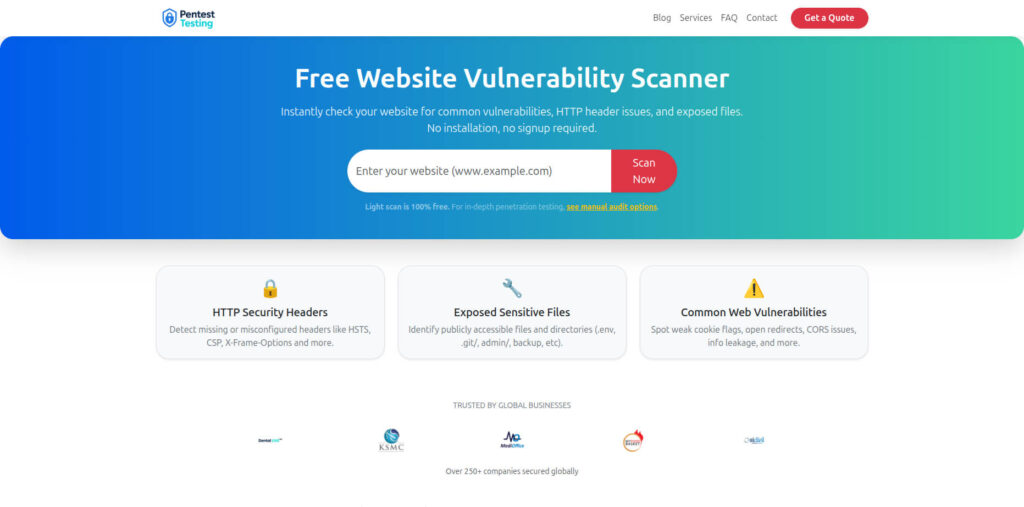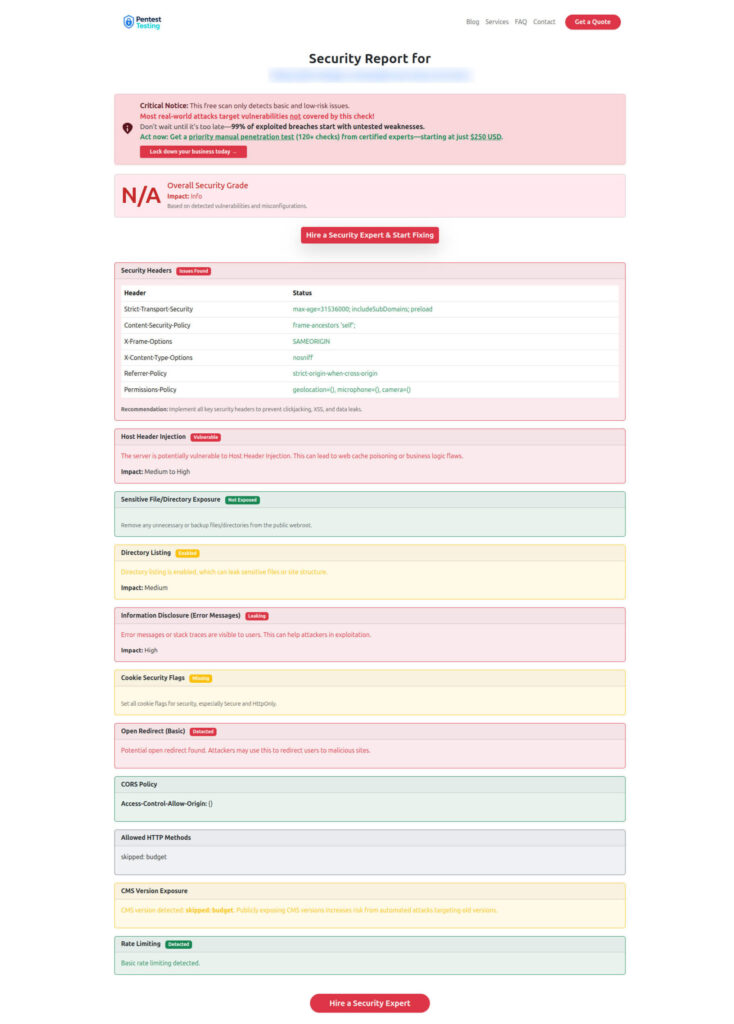Unrestricted File Upload in WordPress (Complete Guide)
Unrestricted File Upload in WordPress is one of those deceptively simple weaknesses that can lead to site takeover, malware injection, SEO spam, and data exfiltration. In this guide, I’ll break down how the vulnerability happens, how to detect it quickly, and 10 proven, developer-friendly fixes with real code you can paste into your theme/plugin. You’ll also find a practical pentesting checklist and resources to harden your stack—fast.

1) What is Unrestricted File Upload in WordPress?
Unrestricted File Upload in WordPress occurs when an application accepts uploaded files without robust validation (extension, MIME, content), authorization (capabilities/roles), and storage controls (e.g., disabling PHP execution in wp-content/uploads). Attackers can smuggle polyglot files (image+PHP), double extensions (avatar.jpg.php), or SVGs with embedded scripts—leading to remote code execution, defacements, or malware.
2) Red Flags & Quick Diagnostics
- Front-end upload forms without
nonceor role checks. - Custom AJAX/REST endpoints that allow any authenticated user to upload executable files.
- Lack of server rules to block
.php,.phar,.phtmlinuploads/. - Accepting SVG or unknown MIME types without sanitization.
- Filenames preserved verbatim (risk of double extensions and path traversal).
- No image re-encoding (risk of image polyglots).
- Content-Type spoofing accepted at face value.
If several of these ring true, you likely have (or are close to) Unrestricted File Upload in WordPress.
3) Ten Proven Fixes (Copy-Ready)
The snippets below assume a custom plugin or your theme’s
functions.php. Prefer a site-specific plugin for portability.
Fix 1 — Strict Allowlist (extensions + real MIME)
add_filter('wp_handle_upload_prefilter', function ($file) {
// 1) Limit size (e.g., 5 MB)
$max_bytes = 5 * 1024 * 1024;
if ($file['size'] > $max_bytes) {
$file['error'] = 'File too large. Max 5MB.';
return $file;
}
// 2) Allowlist by extension AND MIME
$allowed_exts = ['jpg','jpeg','png','gif','webp','pdf'];
$allowed_mimes = ['image/jpeg','image/png','image/gif','image/webp','application/pdf'];
$ext = strtolower(pathinfo($file['name'], PATHINFO_EXTENSION));
$mime = mime_content_type($file['tmp_name']); // or finfo
$wp_type = wp_check_filetype_and_ext($file['tmp_name'], $file['name'], $allowed_mimes);
if (!in_array($ext, $allowed_exts, true)) {
$file['error'] = 'Extension not allowed.';
return $file;
}
if (!in_array($mime, $allowed_mimes, true) || empty($wp_type['ext'])) {
$file['error'] = 'MIME/content mismatch detected.';
return $file;
}
// 3) Reject double extensions (e.g., .jpg.php)
if (preg_match('/\.(php\d*|phtml|phar)$/i', $file['name'])) {
$file['error'] = 'Executable extensions are blocked.';
}
return $file;
});Why it helps: Tackles common bypasses behind Unrestricted File Upload in WordPress by verifying extension + real content.
Screenshot of the free Website Vulnerability Scanner homepage

Fix 2 — Re-encode Images to Destroy Polyglots
function ptc_reencode_image($path) {
$type = exif_imagetype($path);
if (!$type || !in_array($type, [IMAGETYPE_JPEG, IMAGETYPE_PNG, IMAGETYPE_GIF, IMAGETYPE_WEBP], true)) {
return false; // Not a supported raster image
}
switch ($type) {
case IMAGETYPE_JPEG: $img = imagecreatefromjpeg($path); break;
case IMAGETYPE_PNG: $img = imagecreatefrompng($path); break;
case IMAGETYPE_GIF: $img = imagecreatefromgif($path); break;
case IMAGETYPE_WEBP: $img = imagecreatefromwebp($path); break;
}
if (!$img) return false;
// Overwrite with a clean re-encoded file (strips malicious extras/metadata)
imageinterlace($img, true);
$ok = imagejpeg($img, $path, 90);
imagedestroy($img);
return $ok;
}
add_filter('wp_handle_upload', function ($upload) {
if (!empty($upload['file'])) {
ptc_reencode_image($upload['file']); // ignore non-images
}
return $upload;
});Why it helps: Image re-encoding strips suspicious chunks/metadata—neutralizing many image polyglot tricks.
Fix 3 — Block PHP Execution in uploads/ (Apache & Nginx)
Apache (wp-content/uploads/.htaccess):
# Apache 2.4+
<FilesMatch "\.(php|phtml|phar)$">
Require all denied
</FilesMatch>
# Safety: treat these as plain text if encountered
AddType text/plain .php .phtml .phar
RemoveHandler .php .phtml .pharNginx:
location ~* ^/wp-content/uploads/.*\.(php|phtml|phar)$ {
deny all;
return 403;
}Why it helps: Even if an attacker slips a PHP file in, it won’t execute—a key guardrail against Unrestricted File Upload in WordPress exploitation.
Fix 4 — Nonce + Capability Checks for Front-end Uploads
// Form (theme template)
wp_nonce_field('ptc_front_upload', 'ptc_front_upload_nonce');
if (current_user_can('upload_files')): ?>
<form method="post" enctype="multipart/form-data">
<input type="file" name="ptc_file" required>
<button type="submit">Upload</button>
</form>
<?php endif; ?>
<?php
// Handler (functions.php)
add_action('init', function () {
if (!isset($_FILES['ptc_file'])) return;
if (!isset($_POST['ptc_front_upload_nonce']) ||
!wp_verify_nonce($_POST['ptc_front_upload_nonce'], 'ptc_front_upload')) {
wp_die('Invalid request.');
}
if (!current_user_can('upload_files')) {
wp_die('Insufficient permissions.');
}
require_once ABSPATH . 'wp-admin/includes/file.php';
$overrides = ['test_form' => false]; // since we use our own nonce
$file = wp_handle_upload($_FILES['ptc_file'], $overrides);
if (isset($file['error'])) {
wp_die('Upload failed: ' . esc_html($file['error']));
}
echo 'Uploaded: ' . esc_html($file['url']);
});Why it helps: Stops CSRF and unauthorized uploads—two major pathways to Unrestricted File Upload in WordPress.
Fix 5 — File Size Limits & Rate Limiting
WordPress filter:
add_filter('upload_size_limit', function ($bytes) {
// e.g., 5MB hard limit
return 5 * 1024 * 1024;
});Nginx (throttle abuse):
client_max_body_size 5m;
limit_req_zone $binary_remote_addr zone=upload:10m rate=5r/m;
location ~* ^/wp-json/wp/v2/media {
limit_req zone=upload burst=10 nodelay;
}Why it helps: Prevents resource exhaustion and keeps malicious high-volume upload attempts under control.
Sample Assessment Report generated by our tool to check Website Vulnerability

Fix 6 — Offload Uploads to S3 (No PHP execution)
Conceptually, storing media on S3 or an object store (such as Cloudflare R2) with pre-signed URLs mitigates the risk of PHP execution.
Server-side pre-signed (conceptual PHP):
// Pseudo-code: generate a short-lived pre-signed URL server-side
// Then POST/PUT the file directly from the browser to the object store.
// Ensure Content-Type and size constraints on the signature.Why it helps: Files never land in your PHP webroot—reducing the blast radius of Unrestricted File Upload in WordPress.
Fix 7 — Sanitize Filenames & Kill Double Extensions
add_filter('sanitize_file_name', function ($filename) {
$filename = remove_accents($filename);
$filename = preg_replace('/[^A-Za-z0-9\.\-_]/', '-', $filename);
$filename = preg_replace('/-+/', '-', $filename);
// prevent .php.jpg or similar
if (preg_match('/\.(php\d*|phtml|phar)(\.|$)/i', $filename)) {
$filename = preg_replace('/\.(php\d*|phtml|phar)(\.|$)/i', '.', $filename);
}
return strtolower($filename);
}, 10);
Fix 8 — Antivirus / Content Scanning Hook
add_filter('wp_handle_upload', function ($upload) {
if (empty($upload['file'])) return $upload;
$blob = file_get_contents($upload['file']);
// EICAR test string detection (simple sanity check, not production AV):
if (strpos($blob, 'EICAR-STANDARD-ANTIVIRUS-TEST-FILE') !== false) {
@unlink($upload['file']);
$upload['error'] = 'Malicious pattern detected.';
}
return $upload;
});Tip: Integrate a real AV engine (e.g., a ClamAV microservice) asynchronously, and quarantine suspicious files.
Fix 9 — Treat SVG as Code (Sanitize or Block)
add_filter('upload_mimes', function ($mimes) {
// Option A: Block SVG entirely
// unset($mimes['svg']);
// Option B: Allow only for admins; sanitize afterward
if (current_user_can('manage_options')) {
$mimes['svg'] = 'image/svg+xml';
}
return $mimes;
});
add_filter('wp_handle_upload', function ($upload) {
if (!empty($upload['file']) && str_ends_with(strtolower($upload['file']), '.svg')) {
// Run your SVG sanitizer here (DOMDocument + whitelist clean).
// If sanitizer fails, unlink + set $upload['error'].
}
return $upload;
});Fix 10 — Harden Custom REST/AJAX Upload Endpoints
If you built a custom uploader, secure the endpoint:
add_action('rest_api_init', function () {
register_rest_route('ptc/v1', '/upload', [
'methods' => 'POST',
'callback' => function (WP_REST_Request $req) {
if (!is_user_logged_in() || !current_user_can('upload_files')) {
return new WP_Error('forbidden', 'Not allowed.', ['status' => 403]);
}
// Verify WP nonce from X-WP-Nonce header
$nonce = $req->get_header('x-wp-nonce');
if (!$nonce || !wp_verify_nonce($nonce, 'wp_rest')) {
return new WP_Error('bad_nonce', 'Invalid nonce.', ['status' => 403]);
}
// Handle file safely (similar to Fix #1 + #2)
// ...
return ['ok' => true];
},
'permission_callback' => '__return_true',
]);
});Client upload (fetch) with REST nonce:
<script>
async function uploadFile(file) {
const nonce = window.wpApiSettings?.nonce; // Provided by wp_localize_script
const form = new FormData();
form.append('file', file, file.name);
const res = await fetch('/wp-json/ptc/v1/upload', {
method: 'POST',
headers: { 'X-WP-Nonce': nonce },
body: form
});
const data = await res.json();
console.log(data);
}
</script>4) Pentesting Checklist (Safe & Ethical)
Use this ethical checklist to verify defenses against Unrestricted File Upload in WordPress:
- Try uploading non-image files; confirm rejection.
- Upload images with wrong MIME (e.g., rename
.exeto.png); should fail. - Ensure
uploads/never executes PHP (403 Forbidden). - Attempt double extensions & excessive size files; verify blocks.
- Test front-end forms for nonce and capability requirements.
- Try SVG; ensure blocked or sanitized.
- Verify image re-encoding (polyglot stripped).
- Load test uploads with rate limits enabled.
5) Related Reading & Hardening Guides
- Prevent file inclusion attacks after upload:
👉 File Inclusion Vulnerability in WordPress - Stop cross-site request abuse on forms:
👉 CSRF Prevention in WordPress - Shore up backend APIs and DB queries:
👉 Preventing SQL Injection (SQLi) in Laravel - Prevent Clickjacking in WordPress before an attack:
👉 Clickjacking Prevention in WordPress - Understand broken object-level access patterns:
👉 Fix IDOR Vulnerability in Node.js (Cybersrely) - Browse more on our blog:
👉 Pentest Testing Blog
6) Service Pages (Fast Help from Our Team)
Managed IT Services
We secure, monitor, and manage your stack—end to end.
- 24/7 monitoring, patching, and backups
- WAF/CDN configuration and upload hardening
- Incident response & malware cleanup
👉 https://www.pentesttesting.com/managed-it-services/
AI Application Cybersecurity
Protect ML pipelines, model endpoints, and AI-powered plugins.
- Prompt injection defenses, RAG hardening
- Secure file ingestion for LLM apps (MIME & sandboxing)
👉 https://www.pentesttesting.com/ai-application-cybersecurity/
Offer Cybersecurity Service to Your Client
Agencies: white-label our audits and hardening playbooks.
- Rapid assessments, ready-to-send reports
- Revenue-share & partner enablement
👉 https://www.pentesttesting.com/offer-cybersecurity-service-to-your-client/
7) Conclusion & Next Steps
Unrestricted File Upload in WordPress is preventable with a disciplined, layered approach: validate + sanitize + re-encode + block execution + authorize. Start by running a quick scan and then apply the 10 fixes above—today.
- Run a fast check now → https://free.pentesttesting.com/
- Deep-dive tutorials → Pentest Testing Corp. Blog
- Need expert help? See our Managed IT, AI Security, or Partner services linked above.
Bonus: Copy-Paste Server Rules Summary
Apache (uploads/.htaccess)
<FilesMatch "\.(php|phtml|phar)$">
Require all denied
</FilesMatch>
AddType text/plain .php .phtml .phar
RemoveHandler .php .phtml .pharNginx
location ~* ^/wp-content/uploads/.*\.(php|phtml|phar)$ {
deny all;
return 403;
}
client_max_body_size 5m;🔐 Frequently Asked Questions (FAQs)
Find answers to commonly asked questions about Unrestricted File Upload in WordPress.

